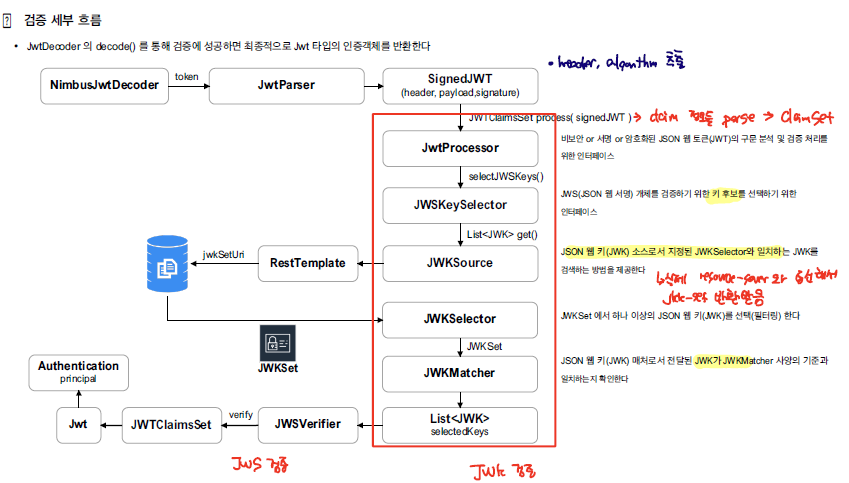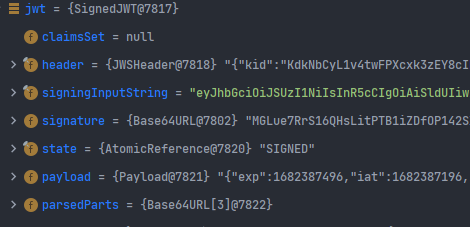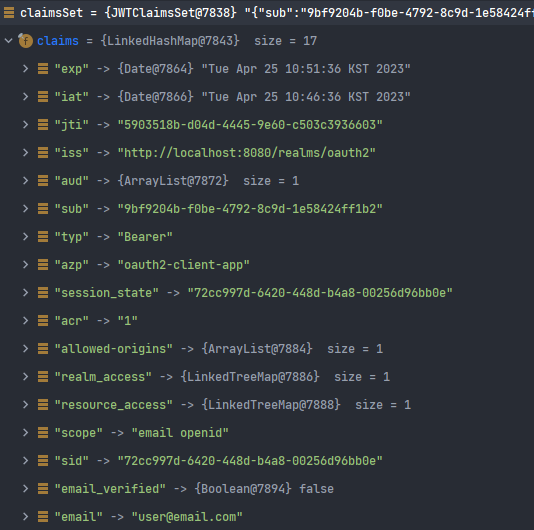Spring Security Oauth2 Part 8
OAuth2 Resource Server
OAuth2 프레임워크 중에서 Resource Server 기능을 수행하는 모듈로 Authorization Server와의 통신을 통해 토큰 검증, Resource 접근 제한의 기능을 처리한다.
Tokens
JWT
- JwtDecoder, BearerTokenAuthenticationFilter, JwtAutheticationProvider와 같은 클래스를 활용하여 인증 로직을 처리한다.
- 자체 검증 프로세스를 가지고 있으며 스프링 내부에서 검증을 처리한다.
Opaque
- 인가 서버의 introspection 엔드 포인트를 통한 토큰 검증을 수행한다.
- JWT Token과 달리 실시간으로 토큰의 활성화 여부를 확인하는 것이 가능하다.
Configuration
build.gradle
dependencies {
implementation 'org.springframework.boot:spring-boot-starter-oauth2-resource-server'
implementation 'org.springframework.boot:spring-boot-starter-security'
implementation 'org.springframework.boot:spring-boot-starter-web'
testImplementation 'org.springframework.boot:spring-boot-starter-test'
testImplementation 'org.springframework.security:spring-security-test'
}
OAuth2 Resource Server을 사용하기 위해서는 아래와 같이 issuer-uri 혹은 jwk-set-uri 정보가 필수적으로 요구된다. 해당 uri 정보를 토대로 JWT 검증에 사용되는 공개키를 인가 서버로부터 가져오는 작업을 수행한다.
application.yml
spring:
security:
oauth2:
resourceserver:
jwt:
issuer-uri: http://localhost:8080/realms/oauth2
jwk-set-uri: http://localhost:8080/realms/oauth2/protocol/openid-connect/certs
인가 서버 메타데이터 엔드포인트에는 아래와 같이 3가지 종류가 있다. issuer uri를 사용하기 위해서는 인가 서버가 아래의 3가지 엔드포인트 중에 하나는 반드시 지원해야한다. keycloak의 경우 첫번째 uri를 통해 엔드포인트 메타 데이터를 반환한다.
- https://localhost:8080/issuer/.well-known/openid-configuration
- https://localhost:8080/.well-known/openid-configuration/issuer
- https://localhost:8080/.well-known/oauth-authorization-server/issuer
위와 같이 gradle 과 application.yml을 설정하게 되면 자동으로 OAuth2ResourceServer에 대한 설정 클래스들이 실행된다.
OAuth2ResourceServerAutoConfiguration
@AutoConfiguration(before = { SecurityAutoConfiguration.class, UserDetailsServiceAutoConfiguration.class })
@EnableConfigurationProperties(OAuth2ResourceServerProperties.class)
@ConditionalOnClass(BearerTokenAuthenticationToken.class)
@ConditionalOnWebApplication(type = ConditionalOnWebApplication.Type.SERVLET)
@Import({ Oauth2ResourceServerConfiguration.JwtConfiguration.class,
Oauth2ResourceServerConfiguration.OpaqueTokenConfiguration.class })
public class OAuth2ResourceServerAutoConfiguration {
}
OAuth2ResourceServerProperties
OAuth2ResourceServerProperties 클래스를 살펴 보면, application.yml에 설정된 값을 토대로, JWT, Opaque token에 대한 정보가 parsing되어 저장되는 것을 확인할 수 있다.
@ConfigurationProperties(prefix = "spring.security.oauth2.resourceserver")
public class OAuth2ResourceServerProperties {
private final Jwt jwt = new Jwt();
public Jwt getJwt() {
return this.jwt;
}
private final Opaquetoken opaqueToken = new Opaquetoken();
public Opaquetoken getOpaquetoken() {
return this.opaqueToken;
}
//JWT
public static class Jwt {
/**
* JSON Web Key URI to use to verify the JWT token.
*/
private String jwkSetUri;
/**
* JSON Web Algorithms used for verifying the digital signatures.
*/
private List<String> jwsAlgorithms = Arrays.asList("RS256");
/**
* URI that can either be an OpenID Connect discovery endpoint or an OAuth 2.0
* Authorization Server Metadata endpoint defined by RFC 8414.
*/
private String issuerUri;
/**
* Location of the file containing the public key used to verify a JWT.
*/
private Resource publicKeyLocation;
//Opaque
public static class Opaquetoken {
/**
* Client id used to authenticate with the token introspection endpoint.
*/
private String clientId;
/**
* Client secret used to authenticate with the token introspection endpoint.
*/
private String clientSecret;
/**
* OAuth 2.0 endpoint through which token introspection is accomplished.
*/
private String introspectionUri;
위의 설정 정보를 토대로, JwtDecoderConfiguration, OpaqueConfiguration이 동작하게 된다.
OAuth2ResourceServerJwtConfiguration
해당 클래스를 내부를 확인해보면, jwk-set-uri, issuer-uri를 토대로 JwtDecoder를 생성하여 Bean으로 등록하는 것을 확인할 수 있다. 또한, SecurityFilterChain도 생성하여 Security에 대한 설정을 처리한다.
@Configuration(proxyBeanMethods = false)
class OAuth2ResourceServerJwtConfiguration {
@Configuration(proxyBeanMethods = false)
@ConditionalOnMissingBean(JwtDecoder.class)
static class JwtDecoderConfiguration {
private final OAuth2ResourceServerProperties.Jwt properties;
JwtDecoderConfiguration(OAuth2ResourceServerProperties properties) {
this.properties = properties.getJwt();
}
@Bean
@ConditionalOnProperty(name = "spring.security.oauth2.resourceserver.jwt.jwk-set-uri")
JwtDecoder jwtDecoderByJwkKeySetUri() {
NimbusJwtDecoder nimbusJwtDecoder = NimbusJwtDecoder.withJwkSetUri(this.properties.getJwkSetUri())
.jwsAlgorithms(this::jwsAlgorithms)
.build();
String issuerUri = this.properties.getIssuerUri();
Supplier<OAuth2TokenValidator<Jwt>> defaultValidator = (issuerUri != null)
? () -> JwtValidators.createDefaultWithIssuer(issuerUri) : JwtValidators::createDefault;
nimbusJwtDecoder.setJwtValidator(getValidators(defaultValidator));
return nimbusJwtDecoder;
}
@Bean
@Conditional(KeyValueCondition.class)
JwtDecoder jwtDecoderByPublicKeyValue() throws Exception {
RSAPublicKey publicKey = (RSAPublicKey) KeyFactory.getInstance("RSA")
.generatePublic(new X509EncodedKeySpec(getKeySpec(this.properties.readPublicKey())));
NimbusJwtDecoder jwtDecoder = NimbusJwtDecoder.withPublicKey(publicKey)
.signatureAlgorithm(SignatureAlgorithm.from(exactlyOneAlgorithm()))
.build();
jwtDecoder.setJwtValidator(getValidators(JwtValidators::createDefault));
return jwtDecoder;
}
@Bean
@Conditional(IssuerUriCondition.class)
SupplierJwtDecoder jwtDecoderByIssuerUri() {
return new SupplierJwtDecoder(() -> {
String issuerUri = this.properties.getIssuerUri();
NimbusJwtDecoder jwtDecoder = JwtDecoders.fromIssuerLocation(issuerUri);
jwtDecoder.setJwtValidator(getValidators(() -> JwtValidators.createDefaultWithIssuer(issuerUri)));
return jwtDecoder;
});
}
}
//Security Filter Chain
@Configuration(proxyBeanMethods = false)
@ConditionalOnDefaultWebSecurity
static class OAuth2SecurityFilterChainConfiguration {
@Bean
@ConditionalOnBean(JwtDecoder.class)
SecurityFilterChain jwtSecurityFilterChain(HttpSecurity http) throws Exception {
http.authorizeHttpRequests((requests) -> requests.anyRequest().authenticated());
http.oauth2ResourceServer(OAuth2ResourceServerConfigurer::jwt);
return http.build();
}
}
}
OAuth2ResourceServerConfigurer
위의 SecurityFilterChain 객체 생성으로 OAuth2ResourceServerConfigurer가 동작하여 ResourceServer 기능을 수행하기 위한 각종 설정들을 처리하게 된다. 내부 클래스를 확인해보면 아래와 같다.
public final class OAuth2ResourceServerConfigurer<H extends HttpSecurityBuilder<H>>
extends AbstractHttpConfigurer<OAuth2ResourceServerConfigurer<H>, H> {
private static final RequestHeaderRequestMatcher X_REQUESTED_WITH = new RequestHeaderRequestMatcher(
"X-Requested-With", "XMLHttpRequest");
private final ApplicationContext context;
private AuthenticationManagerResolver<HttpServletRequest> authenticationManagerResolver;
private BearerTokenResolver bearerTokenResolver;
//JwtConfigurer
private JwtConfigurer jwtConfigurer;
//OpaqueConfigurer
private OpaqueTokenConfigurer opaqueTokenConfigurer;
//AccessDeninedHandler
private AccessDeniedHandler accessDeniedHandler = new DelegatingAccessDeniedHandler(
new LinkedHashMap<>(Map.of(CsrfException.class, new AccessDeniedHandlerImpl())),
new BearerTokenAccessDeniedHandler());
//AuthenticationEntryPoint
private AuthenticationEntryPoint authenticationEntryPoint = new BearerTokenAuthenticationEntryPoint();
private BearerTokenRequestMatcher requestMatcher = new BearerTokenRequestMatcher();
JwtConfigurer,OpaqueTokenConfigurer와 같이 Token를 처리하기 위한 객체들을 포함하고 있다.
BearerTokenAuthenticationFilter
아래와 같이 BearerToken 기반의 인증을 처리하기 위한 Filter을 생성하는 작업을 담당한다.
@Override
public void configure(H http) {
BearerTokenResolver bearerTokenResolver = getBearerTokenResolver();
this.requestMatcher.setBearerTokenResolver(bearerTokenResolver);
AuthenticationManagerResolver resolver = this.authenticationManagerResolver;
if (resolver == null) {
AuthenticationManager authenticationManager = getAuthenticationManager(http);
resolver = (request) -> authenticationManager;
}
BearerTokenAuthenticationFilter filter = new BearerTokenAuthenticationFilter(resolver);
filter.setBearerTokenResolver(bearerTokenResolver);
filter.setAuthenticationEntryPoint(this.authenticationEntryPoint);
filter.setSecurityContextHolderStrategy(getSecurityContextHolderStrategy());
filter = postProcess(filter);
http.addFilter(filter);
}
BearerTokenAuthenticationEntryPoint
인증이 실패하였을 때, 다시 로그인을 처리하기 위한 AuthenticationEntryPoint을 등록하는 작업
private void registerDefaultEntryPoint(H http) {
ExceptionHandlingConfigurer<H> exceptionHandling = http.getConfigurer(ExceptionHandlingConfigurer.class);
if (exceptionHandling != null) {
ContentNegotiationStrategy contentNegotiationStrategy = http
.getSharedObject(ContentNegotiationStrategy.class);
if (contentNegotiationStrategy == null) {
contentNegotiationStrategy = new HeaderContentNegotiationStrategy();
}
MediaTypeRequestMatcher restMatcher = new MediaTypeRequestMatcher(contentNegotiationStrategy,
MediaType.APPLICATION_ATOM_XML, MediaType.APPLICATION_FORM_URLENCODED, MediaType.APPLICATION_JSON,
MediaType.APPLICATION_OCTET_STREAM, MediaType.APPLICATION_XML, MediaType.MULTIPART_FORM_DATA,
MediaType.TEXT_XML);
restMatcher.setIgnoredMediaTypes(Collections.singleton(MediaType.ALL));
MediaTypeRequestMatcher allMatcher = new MediaTypeRequestMatcher(contentNegotiationStrategy, MediaType.ALL);
allMatcher.setUseEquals(true);
RequestMatcher notHtmlMatcher = new NegatedRequestMatcher(
new MediaTypeRequestMatcher(contentNegotiationStrategy, MediaType.TEXT_HTML));
RequestMatcher restNotHtmlMatcher = new AndRequestMatcher(
Arrays.<RequestMatcher>asList(notHtmlMatcher, restMatcher));
RequestMatcher preferredMatcher = new OrRequestMatcher(
Arrays.asList(this.requestMatcher, X_REQUESTED_WITH, restNotHtmlMatcher, allMatcher));
exceptionHandling.defaultAuthenticationEntryPointFor(this.authenticationEntryPoint, preferredMatcher);
}
}
Jwt 토큰 검증
Bearer Token을 전달하게 되면 Resource Server에서는 해당 토큰에 대한 검증을 처리한다. 이때, jwk-set-uri 엔드포인트가 활용된다.
검증은 크게 2가지 단계로 이루어진다.
- jwk-set-uri을 통해 공개키를 받아서 검증을 수행한다.
- Issuer-uri에 대한 JWT 클레임에 대한 검증을 수행한다.
이 모든 과정은 JwtDecoder에 의해서 처리된다.
Spring Security에서는 NimbusJwtDecoder가 default으로 동작하게 된다. NimbusJwtDecoder는 아래와 같이 크게 3가지 방법으로 만들 수 있다. 해당 프로젝트의 경우, jwk-set-uri을 기반으로 동작하기 때문에, JwtSetUriJwtDecoderBuilder 클래스가 동작하게 된다.

검증 프로세스

- JwtAuthenticationProvider에 의해서 Jwt 검증을 호출된다.
//JwtAuthenticationProvider
@Override
public Authentication authenticate(Authentication authentication) throws AuthenticationException {
BearerTokenAuthenticationToken bearer = (BearerTokenAuthenticationToken) authentication;
Jwt jwt = getJwt(bearer);
AbstractAuthenticationToken token = this.jwtAuthenticationConverter.convert(jwt);
token.setDetails(bearer.getDetails());
this.logger.debug("Authenticated token");
return token;
}
private Jwt getJwt(BearerTokenAuthenticationToken bearer) {
try {
return this.jwtDecoder.decode(bearer.getToken());
}
catch (BadJwtException failed) {
this.logger.debug("Failed to authenticate since the JWT was invalid");
throw new InvalidBearerTokenException(failed.getMessage(), failed);
}
catch (JwtException failed) {
throw new AuthenticationServiceException(failed.getMessage(), failed);
}
}
//NimbusJwtDecoder
@Override
public Jwt decode(String token) throws JwtException {
JWT jwt = parse(token);
if (jwt instanceof PlainJWT) {
this.logger.trace("Failed to decode unsigned token");
throw new BadJwtException("Unsupported algorithm of " + jwt.getHeader().getAlgorithm());
}
Jwt createdJwt = createJwt(token, jwt);
return validateJwt(createdJwt);
}
- JwtParser에 의해 JWT가 parsing 된다.
//JwtParser
private JWT parse(String token) {
try {
return JWTParser.parse(token);
}
catch (Exception ex) {
this.logger.trace("Failed to parse token", ex);
throw new BadJwtException(String.format(DECODING_ERROR_MESSAGE_TEMPLATE, ex.getMessage()), ex);
}
}
public static JWT parse(final String s)
throws ParseException {
final int firstDotPos = s.indexOf(".");
if (firstDotPos == -1)
throw new ParseException("Invalid JWT serialization: Missing dot delimiter(s)", 0);
Base64URL header = new Base64URL(s.substring(0, firstDotPos));
Map<String, Object> jsonObject;
try {
jsonObject = JSONObjectUtils.parse(header.decodeToString());
} catch (ParseException e) {
throw new ParseException("Invalid unsecured/JWS/JWE header: " + e.getMessage(), 0);
}
Algorithm alg = Header.parseAlgorithm(jsonObject);
if (alg.equals(Algorithm.NONE)) {
return PlainJWT.parse(s);
} else if (alg instanceof JWSAlgorithm) {
return SignedJWT.parse(s);
} else if (alg instanceof JWEAlgorithm) {
return EncryptedJWT.parse(s);
} else {
throw new AssertionError("Unexpected algorithm type: " + alg);
}
}
//SignedJwt
public static SignedJWT parse(final String s)
throws ParseException {
Base64URL[] parts = JOSEObject.split(s);
if (parts.length != 3) {
throw new ParseException("Unexpected number of Base64URL parts, must be three", 0);
}
return new SignedJWT(parts[0], parts[1], parts[2]);
}
위의 과정을 통해 아래와 같이, header,payloag,signature이 parsing된다.

- JwtProcessor을 통해 JwtClaimSet 처리
Jwt에 대한 구문 분석 및 검증 처리를 위한 인터페이스다.
//NimbusJwtDecoder
private Jwt createJwt(String token, JWT parsedJwt) {
try {
// Verify the signature
JWTClaimsSet jwtClaimsSet = this.jwtProcessor.process(parsedJwt, null);
//DefaultJwsProcessor
@Override
public JWTClaimsSet process(final JWT jwt, final C context)
throws BadJOSEException, JOSEException {
if (jwt instanceof SignedJWT) {
return process((SignedJWT)jwt, context);
}
if (jwt instanceof EncryptedJWT) {
return process((EncryptedJWT)jwt, context);
}
if (jwt instanceof PlainJWT) {
return process((PlainJWT)jwt, context);
}
// Should never happen
throw new JOSEException("Unexpected JWT object type: " + jwt.getClass());
}
@Override
public JWTClaimsSet process(final SignedJWT signedJWT, final C context)
throws BadJOSEException, JOSEException {
if (jwsTypeVerifier == null) {
throw new BadJOSEException("Signed JWT rejected: No JWS header typ (type) verifier is configured");
}
jwsTypeVerifier.verify(signedJWT.getHeader().getType(), context);
if (getJWSKeySelector() == null && getJWTClaimsSetAwareJWSKeySelector() == null) {
// JWS key selector may have been deliberately omitted
throw new BadJOSEException("Signed JWT rejected: No JWS key selector is configured");
}
if (getJWSVerifierFactory() == null) {
throw new JOSEException("No JWS verifier is configured");
}
JWTClaimsSet claimsSet = extractJWTClaimsSet(signedJWT);
위의 결과로 아래와 같이 claim들이 parsing된다.

- JWSKeySelector에 의해 Jwt 검증을 위한 키 후보를 탐색한다.
//DefaultJWTProcessor
@Override
public JWTClaimsSet process(final SignedJWT signedJWT, final C context)
...
List<? extends Key> keyCandidates = selectKeys(signedJWT.getHeader(), claimsSet, context);
...
private List<? extends Key> selectKeys(final JWSHeader header, final JWTClaimsSet claimsSet, final C context)
throws KeySourceException, BadJOSEException {
if (getJWTClaimsSetAwareJWSKeySelector() != null) {
return getJWTClaimsSetAwareJWSKeySelector().selectKeys(header, claimsSet, context);
} else if (getJWSKeySelector() != null) {
return getJWSKeySelector().selectJWSKeys(header, context);
} else {
throw new BadJOSEException("Signed JWT rejected: No JWS key selector is configured");
}
}
//JWSVerificationKeySelector
@Override
public List<Key> selectJWSKeys(final JWSHeader jwsHeader, final C context)
throws KeySourceException {
if (! jwsAlgs.contains(jwsHeader.getAlgorithm())) {
// Unexpected JWS alg
return Collections.emptyList();
}
JWKMatcher jwkMatcher = createJWKMatcher(jwsHeader);
if (jwkMatcher == null) {
return Collections.emptyList();
}
List<JWK> jwkMatches = getJWKSource().get(new JWKSelector(jwkMatcher), context);
...
}
- JWKSource를 통해 인가 서버와 통신을 수행하여 키를 검색한다.
캐시를 확인해서 JwkSet이 존재하면 캐시로부터 받아오고, 그렇지 않으면 RestTemplate을 활용하여 인가서버로 부터 키 후보를 받아온다.
//RemoteJwtSet
@Override
public List<JWK> get(final JWKSelector jwkSelector, final C context)
throws RemoteKeySourceException {
// Check the cache first
JWKSet jwkSet = jwkSetCache.get();
if (jwkSetCache.requiresRefresh() || jwkSet == null) {
// JWK set update required
try {
// Prevent multiple cache updates in case of concurrent requests
// (with double-checked locking, i.e. locking on update required only)
synchronized (this) {
jwkSet = jwkSetCache.get();
if (jwkSetCache.requiresRefresh() || jwkSet == null) {
// Retrieve JWK set from URL
jwkSet = updateJWKSetFromURL();
...
}
//
private JWKSet updateJWKSetFromURL()
throws RemoteKeySourceException {
Resource res;
try {
res = jwkSetRetriever.retrieveResource(jwkSetURL);
} catch (IOException e) {
throw new RemoteKeySourceException("Couldn't retrieve remote JWK set: " + e.getMessage(), e);
}
JWKSet jwkSet;
try {
jwkSet = JWKSet.parse(res.getContent());
} catch (java.text.ParseException e) {
throw new RemoteKeySourceException("Couldn't parse remote JWK set: " + e.getMessage(), e);
}
jwkSetCache.put(jwkSet);
return jwkSet;
}
@Override
public Resource retrieveResource(URL url) throws IOException {
HttpHeaders headers = new HttpHeaders();
headers.setAccept(Arrays.asList(MediaType.APPLICATION_JSON, APPLICATION_JWK_SET_JSON));
ResponseEntity<String> response = getResponse(url, headers);
if (response.getStatusCodeValue() != 200) {
throw new IOException(response.toString());
}
return new Resource(response.getBody(), "UTF-8");
}
private ResponseEntity<String> getResponse(URL url, HttpHeaders headers) throws IOException {
try {
RequestEntity<Void> request = new RequestEntity<>(headers, HttpMethod.GET, url.toURI());
return this.restOperations.exchange(request, String.class);
}
catch (Exception ex) {
throw new IOException(ex);
}
}
위의 결과로 아래의 JwkSet이 반환된다.

6.JWKSelector을 통해 JWKSet에서 키를 선택한다.
//RemoteJWKSet
@Override
public List<JWK> get(final JWKSelector jwkSelector, final C context)
throws RemoteKeySourceException {
...
/*
JwkSet 탐색 작업 --> 5번 과정
*/
// Run the selector on the JWK set
List<JWK> matches = jwkSelector.select(jwkSet);
if (! matches.isEmpty()) {
// Success
return matches;
}
//JwkSelector
public List<JWK> select(final JWKSet jwkSet) {
List<JWK> selectedKeys = new LinkedList<>();
if (jwkSet == null)
return selectedKeys;
for (JWK key: jwkSet.getKeys()) {
if (matcher.matches(key)) {
selectedKeys.add(key);
}
}
return selectedKeys;
}
7. JWKMatcher을 통해 키가 JWKMatcher의 사양과 부합하는 지 검사한다.
JWKMatcher는 JWSKeySelector에 의해 전달되는데, JWT의 header을 활용하여 생성된다.
//JWSVerificationKeySelector
@Override
public List<Key> selectJWSKeys(final JWSHeader jwsHeader, final C context)
throws KeySourceException {
if (! jwsAlgs.contains(jwsHeader.getAlgorithm())) {
// Unexpected JWS alg
return Collections.emptyList();
}
JWKMatcher jwkMatcher = createJWKMatcher(jwsHeader);
if (jwkMatcher == null) {
return Collections.emptyList();
}
List<JWK> jwkMatches = getJWKSource().get(new JWKSelector(jwkMatcher), context);
...
}
protected JWKMatcher createJWKMatcher(final JWSHeader jwsHeader) {
if (! isAllowed(jwsHeader.getAlgorithm())) {
// Unexpected JWS alg
return null;
} else {
return JWKMatcher.forJWSHeader(jwsHeader);
}
}
//JwkSelector
public final class JWKSelector {
/**
* The JWK matcher.
*/
private final JWKMatcher matcher;
public List<JWK> select(final JWKSet jwkSet) {
List<JWK> selectedKeys = new LinkedList<>();
if (jwkSet == null)
return selectedKeys;
for (JWK key: jwkSet.getKeys()) {
if (matcher.matches(key)) {
selectedKeys.add(key);
}
}
return selectedKeys;
}
}
8. JWSVerifier에 의해 JWT 검증을 수행한다.
//DefaultJWTProcessor
@Override
public JWTClaimsSet process(final SignedJWT signedJWT, final C context)
throws BadJOSEException, JOSEException {
List<? extends Key> keyCandidates = selectKeys(signedJWT.getHeader(), claimsSet, context);
if (keyCandidates == null || keyCandidates.isEmpty()) {
throw new BadJOSEException("Signed JWT rejected: Another algorithm expected, or no matching key(s) found");
}
ListIterator<? extends Key> it = keyCandidates.listIterator();
while (it.hasNext()) {
JWSVerifier verifier = getJWSVerifierFactory().createJWSVerifier(signedJWT.getHeader(), it.next());
if (verifier == null) {
continue;
}
final boolean validSignature = signedJWT.verify(verifier);
if (validSignature) {
return verifyClaims(claimsSet, context);
}
if (! it.hasNext()) {
// No more keys to try out
throw new BadJWSException("Signed JWT rejected: Invalid signature");
}
}
throw new BadJOSEException("JWS object rejected: No matching verifier(s) found");
}
//JWSVerifier
@Override
public JWSVerifier createJWSVerifier(final JWSHeader header, final Key key)
throws JOSEException {
JWSVerifier verifier;
if (MACVerifier.SUPPORTED_ALGORITHMS.contains(header.getAlgorithm())) {
if (!(key instanceof SecretKey)) {
throw new KeyTypeException(SecretKey.class);
}
SecretKey macKey = (SecretKey)key;
verifier = new MACVerifier(macKey);
} else if (RSASSAVerifier.SUPPORTED_ALGORITHMS.contains(header.getAlgorithm())) {
if (!(key instanceof RSAPublicKey)) {
throw new KeyTypeException(RSAPublicKey.class);
}
RSAPublicKey rsaPublicKey = (RSAPublicKey)key;
verifier = new RSASSAVerifier(rsaPublicKey);
} else if (ECDSAVerifier.SUPPORTED_ALGORITHMS.contains(header.getAlgorithm())) {
if (!(key instanceof ECPublicKey)) {
throw new KeyTypeException(ECPublicKey.class);
}
ECPublicKey ecPublicKey = (ECPublicKey)key;
verifier = new ECDSAVerifier(ecPublicKey);
} else {
throw new JOSEException("Unsupported JWS algorithm: " + header.getAlgorithm());
}
// Apply JCA context, SecureRandom expensive and not needed for verification (iss #385)
verifier.getJCAContext().setProvider(jcaContext.getProvider());
return verifier;
}
//JWSObject
public synchronized boolean verify(final JWSVerifier verifier)
throws JOSEException {
ensureSignedOrVerifiedState();
boolean verified;
try {
verified = verifier.verify(getHeader(), getSigningInput(), getSignature());
} catch (JOSEException e) {
throw e;
} catch (Exception e) {
// Prevent throwing unchecked exceptions at this point,
// see issue #20
throw new JOSEException(e.getMessage(), e);
}
if (verified) {
state.set(State.VERIFIED);
}
return verified;
}
//RSASSAVerifier
@Override
public boolean verify(final JWSHeader header,
final byte[] signedContent,
final Base64URL signature)
throws JOSEException {
if (! critPolicy.headerPasses(header)) {
return false;
}
final Signature verifier = RSASSA.getSignerAndVerifier(header.getAlgorithm(), getJCAContext().getProvider());
try {
verifier.initVerify(publicKey);
} catch (InvalidKeyException e) {
throw new JOSEException("Invalid public RSA key: " + e.getMessage(), e);
}
try {
verifier.update(signedContent);
return verifier.verify(signature.decode());
} catch (SignatureException e) {
return false;
}
}
References
link: inflearn
docs: spring_security

댓글남기기